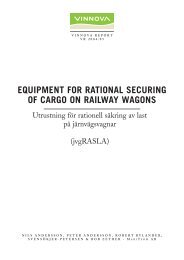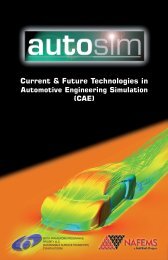WP3: Rail Passenger Transport - TOSCA Project
WP3: Rail Passenger Transport - TOSCA Project
WP3: Rail Passenger Transport - TOSCA Project
Create successful ePaper yourself
Turn your PDF publications into a flip-book with our unique Google optimized e-Paper software.
Note that technology ‘Modular short train’ (PE) or ‘Electrification of non-electrified lines’ (PI)<br />
is not explicitly part of the scenarios, since it is not possible within the scope of this study to<br />
estimate their future feasibility and implementation. PE and PI are therefore also nonquantified<br />
options for additional improvement.<br />
Note also that ‘Bio fuels’ (PH) is not either part of the scenarios at this stage, because the<br />
potential of this option is dependent on uncertain variables being assessed in Stage 2 of<br />
<strong>TOSCA</strong>. The same is e.g. the case for ‘Low-GHG electric power’ (PJ) but a tentative<br />
improvement is anyhow studied in Scenario 8 above, just to understand the possible impact of<br />
low-GHG electric power.<br />
Scenarios 1 to 5 with single measures are comparatively easy to estimate. The combined scenarios<br />
are, however, much more complicated since there are considerable interactions and<br />
dependences between the different measures, if combined. In this context a thorough and<br />
validated simulation software (STEC) is used, taking all factors into consideration in the same<br />
run. In the simulations with STEC the full estimated potential of improvement until year 2050<br />
is used.<br />
As it is very hard to find qualified estimates on rail technology for 2050, the total time 2009-<br />
2050 is divided in two periods. Due to the current lack of future estimates for the railway<br />
sector, the following procedure is being applied:<br />
Period 1 The techno-economic potential for in-service introduction during the next 10–15<br />
years (i.e. until 2025) is estimated according to the earlier mentioned sources.<br />
Period 2<br />
Development is assumed to continue after 2025. For most technologies it is<br />
assumed that 2/3 of the first period achievement can be achieved in the second<br />
period, i.e. 2025–2050, provided there are no obvious physical or economic<br />
obstacles. The exception is technology PB (Low-mass train) that requires more<br />
substantial research before technology readiness (see Table 3-1), which will<br />
delay most to its possible introduction to Period 2.<br />
This means that, for most technologies, 60 % of the total achievement until 2050 is what today<br />
is known or assumed as appropriate technologies, possible to introduce in regular service<br />
during the Period 1, while 40 % is assumed to be achieved during Period 2. As the latter period<br />
is longer than the first one, the annual rate of improvement is assumed to be slower in the<br />
second period. This assumption is justified as the first steps are considered as technically and<br />
economically quite well-founded, while the following steps would likely require more<br />
advanced technologies, also being closer to the physical and economic limits.<br />
If – for example - the total combined improvement is 50 % reduction of specific energy in the<br />
total period (41 years), then the energy will be reduced by 30 % under the first period and by a<br />
further 20 % (of the original amount) in the second of 25 years. This ends up with 2.2 %<br />
average reduction per year until 2025 and 1.4 % reduction per year during 2025–2050. With<br />
the same percentage annual rate the assumed 50 % reduction until 2050 is equivalent to an<br />
annual reduction by 1.7 % per year.<br />
Table 3-1 presents examples of changes for improvement in the first period (until 2025). These<br />
changes have been judged as possible with reference to (mainly) UIC Energy efficiency<br />
strategies for rolling stock and train operation as well as (<strong>Rail</strong>energy, 2009) and (Diedrichs,<br />
2010), i.e. essentially the same as in Section 3.3. They are included in the earlier mentioned 9<br />
scenarios and are investigated both as individual technologeis and in combination. Results are<br />
presented in Section 5.<br />
Deliverable D4 – <strong>WP3</strong> passenger 14
















